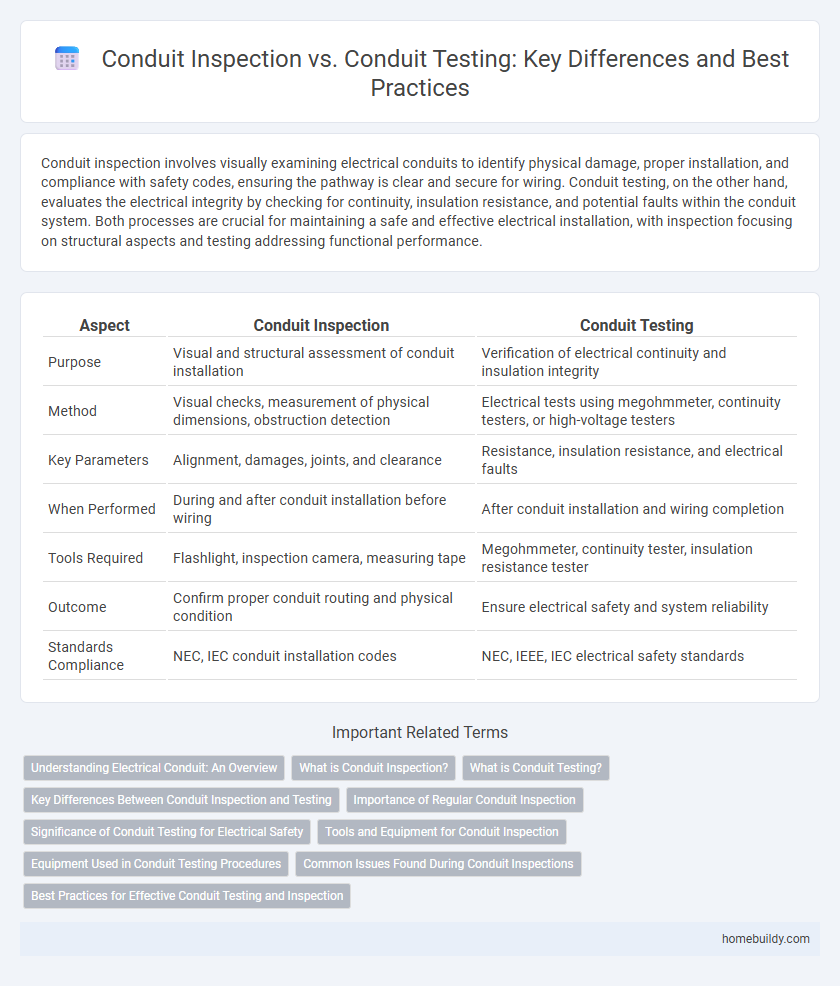Conduit inspection involves visually examining electrical conduits to identify physical damage, proper installation, and compliance with safety codes, ensuring the pathway is clear and secure for wiring. Conduit testing, on the other hand, evaluates the electrical integrity by checking for continuity, insulation resistance, and potential faults within the conduit system. Both processes are crucial for maintaining a safe and effective electrical installation, with inspection focusing on structural aspects and testing addressing functional performance.
Table of Comparison
| Aspect | Conduit Inspection | Conduit Testing |
|---|---|---|
| Purpose | Visual and structural assessment of conduit installation | Verification of electrical continuity and insulation integrity |
| Method | Visual checks, measurement of physical dimensions, obstruction detection | Electrical tests using megohmmeter, continuity testers, or high-voltage testers |
| Key Parameters | Alignment, damages, joints, and clearance | Resistance, insulation resistance, and electrical faults |
| When Performed | During and after conduit installation before wiring | After conduit installation and wiring completion |
| Tools Required | Flashlight, inspection camera, measuring tape | Megohmmeter, continuity tester, insulation resistance tester |
| Outcome | Confirm proper conduit routing and physical condition | Ensure electrical safety and system reliability |
| Standards Compliance | NEC, IEC conduit installation codes | NEC, IEEE, IEC electrical safety standards |
Understanding Electrical Conduit: An Overview
Conduit inspection involves visually examining electrical conduits to ensure proper installation, checking for physical damages, correct placement, and compliance with safety codes. Conduit testing evaluates the integrity of the conduit system by measuring electrical continuity, insulation resistance, and detecting potential faults using specialized instruments. Understanding these processes is essential for maintaining conduit reliability, preventing electrical hazards, and ensuring optimal system performance.
What is Conduit Inspection?
Conduit inspection involves a thorough visual examination to ensure electrical conduits are properly installed, free from physical damage, and compliant with electrical codes. Inspectors check for correct conduit sizing, secure fittings, and appropriate bends to prevent wire damage or signal interference. This process helps identify potential issues before wiring installation, ensuring safety and reliability in electrical systems.
What is Conduit Testing?
Conduit testing involves assessing the electrical conduit system for continuity, integrity, and compliance with safety standards to ensure proper functionality and protection of conductors. It typically includes methods like insulation resistance testing, continuity checks, and pressure testing to identify leaks, cracks, or faults within the conduit. Effective conduit testing prevents electrical hazards and enhances the durability of the wiring infrastructure in residential, commercial, and industrial installations.
Key Differences Between Conduit Inspection and Testing
Conduit inspection primarily focuses on visually examining the physical condition, installation quality, and compliance with electrical codes to ensure safe and proper conduit routing. Conduit testing, on the other hand, involves conducting electrical or mechanical tests such as continuity, insulation resistance, or pressure tests to verify conduit integrity and performance under operational conditions. The key differences lie in inspection addressing visible defects and code adherence, while testing evaluates functional reliability and safety through measurable parameters.
Importance of Regular Conduit Inspection
Regular conduit inspection is crucial for ensuring the integrity and safety of electrical systems by identifying physical damage, corrosion, or improper installation before they lead to failures. Conduit inspection involves visual and mechanical assessments to detect issues such as cracks, deformities, or blockages that can compromise electrical wiring protection. Maintaining a consistent inspection schedule minimizes the risk of electrical hazards, reduces downtime, and ensures compliance with electrical codes and standards.
Significance of Conduit Testing for Electrical Safety
Conduit testing plays a crucial role in electrical safety by verifying the integrity and continuity of conduit systems, ensuring protection against electrical faults and hazards. Unlike conduit inspection, which primarily assesses physical condition and compliance with installation standards, conduit testing identifies hidden defects such as insulation breakdowns or grounding failures. Accurate conduit testing reduces the risk of electrical fires and equipment damage, promoting reliable and safe electrical installations.
Tools and Equipment for Conduit Inspection
Conduit inspection requires specialized tools such as flexible inspection cameras, borescopes, and video inspection systems to visually assess the interior of electrical conduits for blockages, damage, or corrosion. These tools enable detailed real-time imaging in confined spaces, improving accuracy in identifying defects without dismantling the conduit system. Conduit testing, by contrast, often involves equipment like cable locators and continuity testers, which focus on electrical integrity rather than structural conditions.
Equipment Used in Conduit Testing Procedures
Conduit testing procedures primarily utilize specialized equipment such as continuity testers, insulation resistance testers, and high-voltage megohmmeters to ensure the integrity and reliability of electrical conduits. These devices measure parameters like resistance, insulation quality, and detect faults or breaches within the conduit system, providing critical data for safety and compliance. In contrast, conduit inspection often involves visual assessment tools such as borescopes and cameras, focusing on physical condition rather than electrical performance.
Common Issues Found During Conduit Inspections
Conduit inspections frequently reveal issues such as improper bends, crushed sections, and missing or damaged conduit supports that compromise electrical system safety and efficiency. Common defects also include blocked conduits containing debris or moisture, which can lead to wire damage and increased electrical resistance. Detecting these problems early during inspections helps prevent costly repairs and ensures compliance with electrical codes.
Best Practices for Effective Conduit Testing and Inspection
Effective conduit inspection involves visually assessing conduit integrity, ensuring proper installation, correct sizing, and the absence of physical damage or obstructions. Conduit testing focuses on verifying electrical continuity and insulation resistance using specialized tools such as megohmmeters and continuity testers to prevent faults and ensure safety. Best practices combine thorough visual inspections with regular electrical testing, adhering to NEC guidelines and industry standards to maintain system reliability and prevent costly failures.
Conduit inspection vs Conduit testing Infographic

 homebuildy.com
homebuildy.com